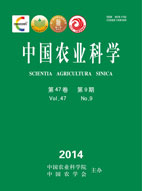-
Effect of Different Concentrations of Organic Matter Fermentation Fluid on the Young Apple Tree Leaf Photosynthesis Fluorescent Parameters and Root Antioxidant Activity Under Replant Conditions
- YIN Cheng-Miao, ZHANG Xian-Fu, HU Yan-Li, SHEN Xiang, CHEN Xue-Sen, WU Shu-Jing, MAO Zhi-Quan
-
Scientia Agricultura Sinica. 2014, 47(9):
1847-1857.
doi:10.3864/j.issn.0578-1752.2014.09.020
-
 Abstract
(
600 )
Abstract
(
600 )
 HTML
(
2 )
HTML
(
2 )
 PDF (649KB)
(
636
)
PDF (649KB)
(
636
)
 Save
Save
-
References |
Related Articles |
Metrics
【Objective】The Fuji/Malus robusta biennial plants were selected as the test materials, and potted with continuous cropping soil. Effect of different concentrations of organic matter fermentation fluid on the young apple tree leaf photosynthesis fluorescent parameters and root antioxidant activity under replant conditions was studied.【Method】Fuji/Malus robusta biennial grafted plants were planted in clay basins. Six organic matter concentrations in the fermentation fluid were designed: CK, CK+1% (T1), CK+3% (T2), CK+5% (T3), CK+7% (T4) and CK+9% (T5). The plant height and basal diameter of young apple tree, superoxide dismutase (SOD) activities, catalase (CAT) activities, peroxidase (POD) activities of roots of young apple tree, the net photosynthetic rate (Pn), transpiration rate (Tr), stomatal conductance (Gs), intercellular carbon dioxide concentration (Ci), actual PSⅡ efficiency (ΦPSⅡ), efficiency of light energy capture by open PSⅡ reaction centers (Fv′/Fm′), non-photochemical quenching of PSⅡ(NPQ), quantum yield of PSⅡ electron transport (ETR), photochemical quenching of PSⅡ(qP) of leaves of young apple tree were determined.【Result】The main results were as follows: the role of organic matter fermentation on the growth, root antioxidant activity and leaf photosynthesis fluorescent parameters of young apple tree showed a “promotion in low concentration and inhibition in high concentration” effect. Low and middle concentrations of organic matter fermentation fluid (1%, 3%, 5%) watered young apple tree plant height was higher than the concurrent control, and 3% treatment had the most significant growth, were 1.24, 1.12 and 1.23 times higher compared with the concurrent control in spring, summer and autumn. The activities of CAT were increased gradually from spring to autumn. In spring and autumn, root CAT activities of other treatments except 3% treatment were significantly lower than that of the control. The root CAT activity in all treatments increased, in addition to 5% treatment, CAT activity in 1%, 3%, 7% and 9% treatments were significantly higher than the control by 1.54, 1.84, 1.65 and 1.62 times in summer. Applying different concentrations of organic material fermentation fluid also changed root POD activity of young apple tree, and in addition to the 7% and 9% treatments, root POD activities in other treatments were increased first and then decreased according to the season. The activities of SOD were decreased gradually from spring to autumn, and in the spring SOD activities of 1%, 3% and 5% treatments were 1.28, 1.34 and 1.24 times higher than the control, while the 7% and 9% treatments were 91.5% and 93.9% lower than the control. Chlorophyll a, chlorophyll b and carotenoid contents of young apple tree leaves in 1%, 3% and 5% treatments were increased gradually from spring to autumn. Chlorophyll a, chlorophyll b, carotenoid and chlorophyll (a+b) contents in 3% treatment were the highest in spring, summer and autumn, and were 1.17, 1.34, 1.09 and 1.22 times of the concurrent control in spring; and were 1.18, 1.29, 1.11 and 1.21 times of the concurrent control in summer, and 1.52, 2.23, 1.42 and 1.65 times of the concurrent control in autumn. In 3% treatment, the leaf Pn, Tr, and Gs of the continuous cropping apple trees increased by 13.8%, 27.3% and 17.3% compared with the control. 【Conclusion】The effects of different concentrations of organic material fermentation fluid on the growth, leaf photosynthesis fluorescent parameters and root antioxidant activity of young apple tree under replant conditions were different, 1%, 3% and 5% treatments could reduce the apple continuous cropping obstacle, and organic material fermentation fluid concentrations higher than 5% inhibited the growth of young apple trees. Therefore, the organic material fermentation fluid concentration of 3% can more effectively reduce the apple continuous cropping obstacle.









